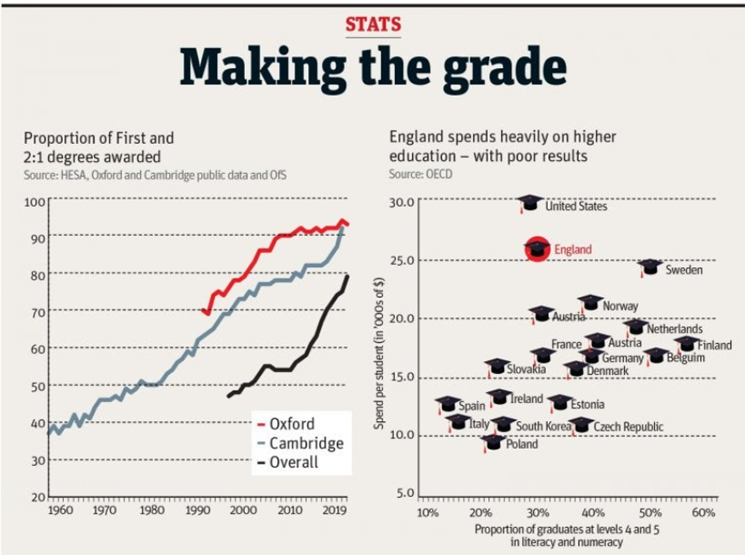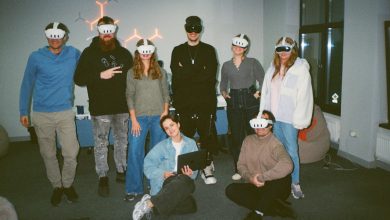
These days, a quick flick through the news is a near-guarantee of seeing yet another prediction of the next job that AI will make obsolete in the next five years. But while it’s true that AI is driving a widespread skill shift across industries, it’s crucial to remember that AI is also one of the most valuable tools that can enable education systems to meet evolving employment needs.
Providing a broad range of educational pathways is a key way that education systems can help foster skill diversity in the future workforce, equalize employment rates across sectors, and reduce the impact of the attainment gap. But many education systems are failing to do this.
The problem of higher education in the UK and US: why we need to diversify career pathways
In the UK, despite the availability of alternative options such as apprenticeships and vocational college courses, students are typically encouraged to apply to study at university once they finish school rather than pursue other pathways. This is because the university route has been traditionally associated with better employability prospects.
However, while statistics on university prospectuses and league tables still point to high employability rates for graduates, the value of higher education has dropped over the last 30 years as university study has become an increasingly mainstream career pathway. In a New Statesman article, Harry Lambert points to increased admission rates as one of the key reasons for this decline in the UK, along with grade inflation, and lack of investment in teaching.
The US has seen a similar decline in the quality of its higher education, with approximately just 30% of its graduates achieving a high level of numeracy and literacy, despite increased spending on education.

The overall decline in educational quality provided by universities in the UK and US is not only wasteful of the resources of both students and academic staff, but is also contributing to the widening skills gap in the employment sector.
With universities awarding degrees to growing numbers of graduates whilst failing to uphold the academic standards that degrees used to denote, employers are facing increased difficulty in scouting the job market for candidates who are equipped with sufficient skills and knowledge to meet their demands.
Furthermore, the education system’s singular advocation of the university pathway can isolate and disadvantage low-attaining students or those who do not want to pursue academic study. In a comment to the Institute for Fiscal Studies, vocational education expert Sandra McNally highlights the need for clearer vocational career paths for low academic achievers in light of recent and ongoing global challenges.
“The options for young people who do not earn good GCSEs at age 16 are limited, confusing and often not very lucrative. Pathways to higher levels of learning are opaque for such learners. The post-compulsory system in general can lead towards narrow choices with little opportunity for second chances later on. Big cuts to adult education budgets over the past two decades have squeezed the sector even further. With challenges like COVID-19 and the Net Zero transition boosting the demand for new skills, providing clear, useful and well-resourced routes in the vocational education sector is more important than ever.”
Sandra McNally, Director of the Centre for Vocational Education Research LSE
AI in recruitment
AI has exciting potential to open up broader educational pathways for students at both the higher and lower educational stages. One key way it can do this is by optimizing recruitment programs. Recruitment programs are already used to some extent to promote access to vocational training programs and apprenticeships, and help clarify career pathways for university graduates.
However, they have some significant limitations: (1) they rely on the initiative of the student/graduate, typically requiring them to navigate a potentially complex and lengthy application procedure, and (2) the database of prospective applicants for recruiters to search through can be narrow and difficult to navigate. AI can up the game of recruitment programs by widening their scope of sources, and optimizing the accuracy and accessibility of candidate data.
The effectiveness of AI in this area is illustrated by a recent collaboration between IBM and Sevilla FC. By combining IBM’s AI software, watsonx, with Sevilla FC’s player database, this partnership has led to the creation of ScoutAdvisor, an innovative new recruitment tool that enables scouts for the football team to easily search through over 200K player reports to find the optimal candidate for an open position.
“Watsonx assesses the similarity between the enriched user prompt and the evaluations of a single player by the team of scouts, drawing from their comprehensive game-player reports. This way, results are ranked according to the alignment with the descriptive assessments provided by scouts regarding player performances and on-field behaviour. This enhances the workflow of scouts, optimizing their efforts by leveraging their own expertise to categorize reports and offer recommendations for individual players.”
Arturo Guerrero (Senior Manager for Client Engineering at IBM), Victoria Gomez (IBM watsonx sales leader), and Miguel Valdivieso (Head of Talent Transformation at IBM).
This demonstrates the potential of AI to broaden the scope of recruitment sources with optimized data storage facilities, reduce the workload in the recruitment process for potential employers and applicants, and improve the accuracy of recruitment with targeted data structuring. Within education, AI could be similarly used to enable more effective collaboration with employers to provide more accurate skill-based matches between their open roles and prospective applicants. Schools, colleges, and universities, which already store student achievement records, could also utilize AI to leverage this data and help students more easily find the best pathway to their desired career or discover new career options that are personalized to their unique skillset.
“Recruitment is one of the main use cases for Generative AI… For recruiters, it provides clear efficiencies in the screening process, but also benefits in the data-based definition of profiles, in the comparative ranking both quantitative and qualitative, and in the logistical and communication management… For candidates, incorporating Generative AI results in a better experience and engagement in the process, allowing them to find positions for which their profile is a much better fit and open direct communication channels to understand and manage the entire selection process, testing, and communications.”
Arturo Guerrero, Victoria Gomez, and Miguel Valdivieso, from IBM
Unlocking the full potential of AI in recruitment requires trust and collaboration between employers and education systems, particularly given the potentially sensitive nature of data in student records. Nevertheless, data sharing and collaborative recruitment initiatives between employers and education systems represent a major application of AI that is poised become increasingly important over the next few years.
Existing collaborative initiatives
In recognition of the value of collaboration with employers within the tech industry, several universities have launched initiatives to promote the targeted use of AI within academic research, and address skill shortages in the tech industry. For example, the University of Edinburgh hosts the Data Lab, a leading research department in AI which enables tech companies to collaborate with students on real-life projects, promotes greater awareness of job opportunities within tech, and provides networking opportunities. Over the last ten years, the Data Lab has partnered with many companies to provide students with opportunities to apply their skills and creativity within the tech industry.
“The Data Lab is part of a broader effort to make Scotland a global leader in these areas. This partnership involves working with students, professionals, universities, colleges, businesses, and the wider community to build a more collaborative economy and future for Scotland and the world. The Data Lab aims to foster innovation through collaboration, build skills and grow talent, and champion Scotland’s data and AI community.”
Sam Netherwood, Head of Behavioural Science, and Albert Phelps, AI R&D, at Tomoro.ai
A similar initiative was launched in the US by the University of Tennessee in partnership with the BlueCross BlueShield Healthcare Association to address the shortage of technology graduates in the state. Moreover, these partnerships, along with the evolution of AI itself, are encouraging employers to recruit from a wider pool of talent.
“The advent of prompting as a paradigm / the best way to get the best performance out of LLMs, will mean that the pool of graduate talent we are reaching out to, and beginning to work with, will be STEM heavy, but not quite as much as before. We’re on the hunt for philosophers, linguists, historians. People who work with words, that want to learn AI. We think this might reflect a necessary change in the way we identify tech capabilities that are more prepared for the future, not just the short term.”
Sam Netherwood and Albert Phelps, from Tomoro.ai
While collaboration with employers in the tech industry is taking place primarily at a higher education level, there are also initiatives aimed at schools to foster interest in STEM subjects and broaden the student skillsets to enhance employability. A great example of this is the FIRST LEGO League (FLL). This global initiative offers opportunities in STEM to a younger demographic of students between the ages 4-16. As the name suggests, this program centres around Lego, using it to engage children in learning through play. It launches competitions, and provides courses and programs which teach children key skills in coding, software development, engineering, and robotics, all within the context of solving real-world issues.
Through a combination of theory, play, and competition, these programs encourage soft skills such as problem-solving, critical thinking, and teamwork all within the context of using tools and technology. This helps to broaden the skillsets of students across subjects and increase their access to a greater variety of employment options.
Dr. Adnan Masood, Chief AI Architect at UST, has collaborated with the FLL on some of their robotics programs. He highlighted that students who participate in the program are far more likely to graduate from high school and pursue a STEM subject in college. A group of students that he coached, for example, all went on to pursue further study in computer science and STEM majors.
“STEM teaches a lot of things that make you more valuable in the job market, and increase your chance of ending up in a future career. It’s a career perspective. It’s really important. Manufacturing, healthcare, agriculture… STEM and robotics provide a basis for really amazing careers in all these sectors. The students who graduate from STEM programs have significant potential to end up at MIT or other robotics schools, or work with employers such as NASA, because they have practical hands-on experience of working with robots.”
Dr. Adnan Masood, Chief AI Architect at UST
Further thoughts
Aside from recruitment and collaborative initiatives between employers and education systems, AI has potential to broaden educational pathways in several other ways.
- Virtual reality (VR) technology could be used to increase access to a greater variety of educational pathways by enabling students to easily explore different career options in an engaging and gamified way that allows them to make mistakes without causing any negative repercussions. Sam Netherwood and Albert Phelps from Tomoro.ai also point out how VR could be combined with Generative AI to enhance the user experience: “VR… has huge potential when combined with gen AI, especially in an educational context. Even in the relatively short term we could create adaptive VR simulations that mirror real life, all within an environment in which it’s safe to get things wrong.”
- The availability of online resources and personalized digital tutoring enables students to better identify their strengths and weaknesses and more easily pursue their individual interests and passions. This may help students to identify the career pathways that appeal to them from an earlier age and encourage them to consider a more diverse range of career pathway options. For those who choose to pursue higher education, it gives them a firmer grasp of the great variety of subjects that can be studied, and what these subjects actually entail. This ultimately enables them to make a more informed decision about their future.
- Another key application for AI is in adapting curricula to become more aligned with the evolving demand for skills in different sectors. With its capacity to read and analyze vast amounts in mere seconds, AI can enable education to gain key insights on how curricula compare to industry demand for skills. As Dr. Mansureh Kebritchi, Research Chair at the University of Phoenix points out, “a major issue in education is aligning the curriculum with industry needs. AI can be used to compare and contrast the content of the curricula with the competencies required by the industry and identify gaps and misalignments. By using AI, educators can close the gap and further align the curricula with industry needs, ultimately enhancing students’ employability.”
The takeaway
Rather than spending time worrying about the potential threat AI poses to the employment sector, we should be thinking about how AI can be best used to enhance candidate employability and optimize the recruitment process.
It is crucial to remember that jobs will evolve to take advantage of AI, not the other way around. And skills, even highly specialized ones, are flexible, adaptable, and are constantly finding evolving applications in new contexts and emerging areas of demand.
Predictions about the expiration date of particular careers are not only unproductive and fear-driven, but also overlook the fact that AI is a double edged sword. Yes, it may trigger lay-offs and cause a temporary spike in redundancy as companies adjust to significant changes in business operation. But AI will also enable advances, solutions, and possibilities that would not be possible without the cooperation of humans with AI. The best way to reduce redundancy from automation is not to limit our use of AI, but is to extend our vision of what is possible in the emerging age of collaboration between humans and AI.
Education systems need to mirror this approach, and embrace AI as a tool that can foster greater collaboration with employers. This will ensure that upcoming generations are well-equipped to find their roles within the seamless human-digital interfaces that are going to shape the future of employment. Schemes such as the FLL are showcasing the vast array of benefits that students are gaining from collaborative schemes which are promoting the use of AI technology within learning.





